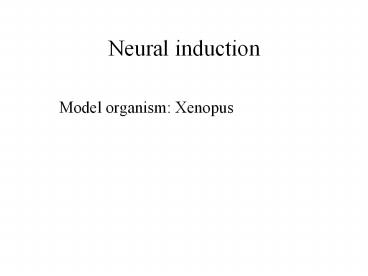Neural induction PowerPoint PPT Presentation
1 / 31
Title: Neural induction
1
Neural induction
- Model organism Xenopus
2
Late blastula
neurula
3
(No Transcript)
4
P31. During gastrulation, tissue interaction
between the involuting dorsal cells (prospective
pharyngeal endoderm and dorsal mesoderm,
collectively referred to as mesendoderm) and the
overlying ectoderm define the region of the
ectoderm that will form the nervous system and
establish principal axes, and direct cells within
this region towards a neural fate. This process
is known as neural induction.
5
(No Transcript)
6
Two topics in this chapter are neural induction
and axial formation
7
discovery of neural induction
8
Hensens node
9
Organizer releases inductive signals. All
ectoderm are competent. Polarity has been
determined.
10
Search for the inducers Animal cap experiment,
artificial inducers, 60 years pass
11
Dissociated cells neurons (neural
default) Dominant negative experiments
Activins, Vg-1 BMPs Activins, inhibins Homodimer,
hetrodimers Promiscuous receptors
12
BMP2, BMP4, BMP7 Noggin, chordin, follistatin
induce primitive neural tissue
BMP inactivation triggers early neural markers,
other factors are required to elicit
differentiated markers
13
WNTs as another class of neural inhibitors in
animal cap explants.
14
Conserved between Drosophila and vertebrate
15
Polarity and establishment of the neuraxis
16
Early ingressing cells become prechodal plate and
induce forebrain. Late ingressing cells become
notochord and induce midbrain, hindbrain, and
spinal cord.
17
Where do signals come from?
18
Holtfreter, urodele
Xenopus, primitive induction OK and showed AP axis
19
- Caveats of planar experiments
- Cant rule out vertical signals (cryptic
gastrulation) - Deeper cells before gastrulation release cerberus
20
- The two-signal model
- General inducers noggin, chordin, follistatin,
induce anterior-like neural tissue, NCAM, Otx2,
BF1. - Posterior factors
- Anterior factors, Wnt vs. Wnt antagonist
- Source of inducers
- 1. Mesendoderm, anterior-to-posterior ingression
- posterior-to-anterior
translocation - 2. The organizer
21
(No Transcript)
22
Posteriorizing signals (transforming signals)
- Retinoic acid (constitutive and dominant-negative
receptors) - FGF (avian beads)
- Wnt
- TGF? members
- Animal cap assay, beads
23
Posteriorizing signals (transforming signals)
- Retinoic acid (constitutive and dominant-negative
receptors) - FGF (avian beads)
- Wnt
- TGF? members
- Animal cap assay, beads
- Forebrain marker BF1, Otx2
- Midbrain marker Otx2, Engrail
- Hindbrain marker Hox, Krox20
24
Specific pathways for head induction
Cerberus
25
Dickkopf
- In presumptive prechordal plate
- Antagonist of Wnt
Activin and nodal-related factors induce
posteriorization in zebrafish Antivin converts
posterior CNS into anterior
26
(No Transcript)
27
Competence of the ectoderm
28
Neural induction in the amniote embryo In mouse,
the anteriormost region of the neural axis is
induced by signals from presumptive
extraembryonic (visceral) endoderm.
Two effects of Otx2 induction, maintenance
29
Mediolateral extent of the neural plate
- BMP conc gradient decides fate of epidermis,
neural crest, neural plate. Experiments from
zebrafish.
epidermis
BMP conc
neural crest
neural plate
E
NP
NC
30
epidermis
BMP conc
neural crest
neural plate
E
NP
NC
epidermis
BMP conc
neural crest
neural plate
E
NP
NC
31
ectoderm
Neural plate
NC
NC
ectoderm
Normal
BMP2-/-
Chordin-/-
Chordin-/-, somitabun

